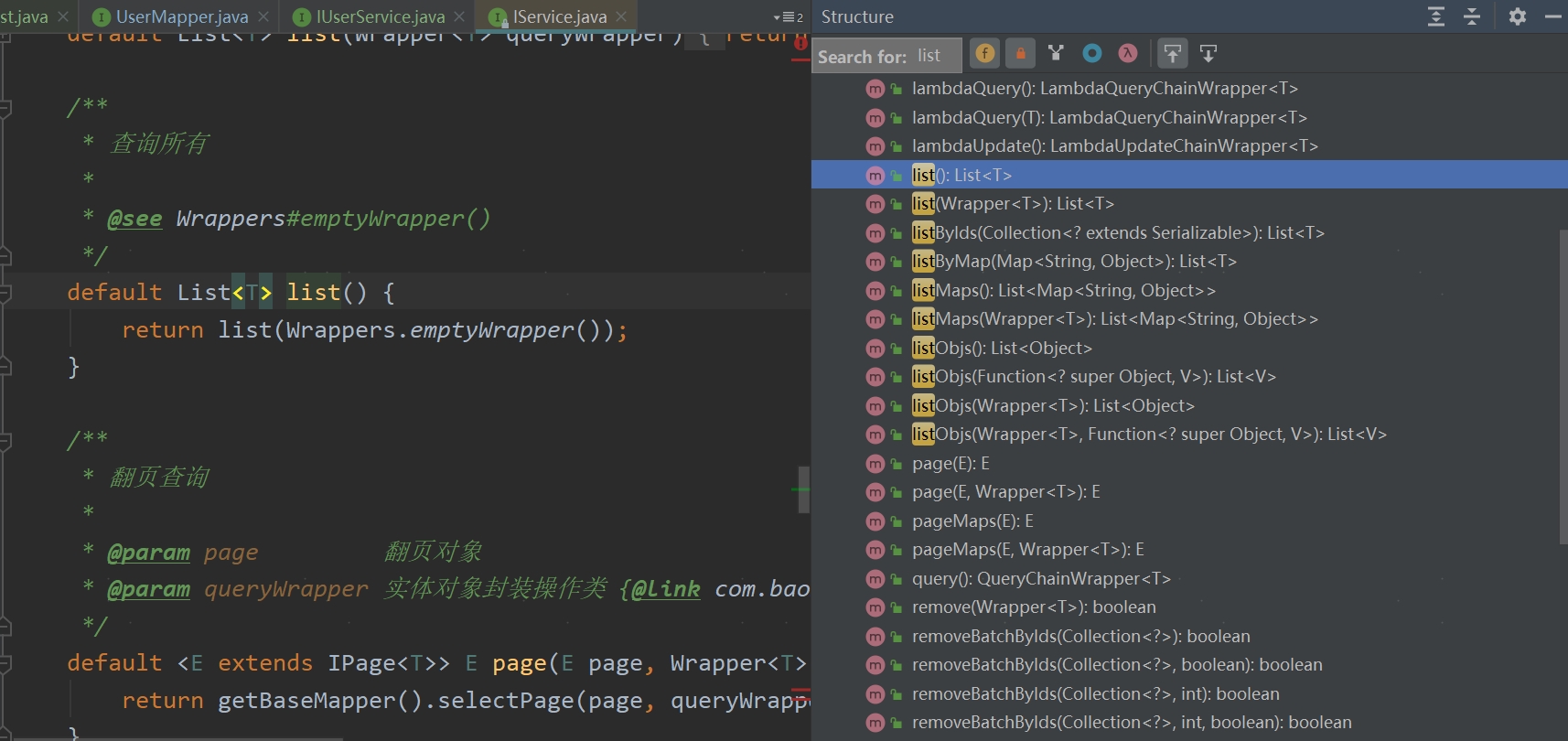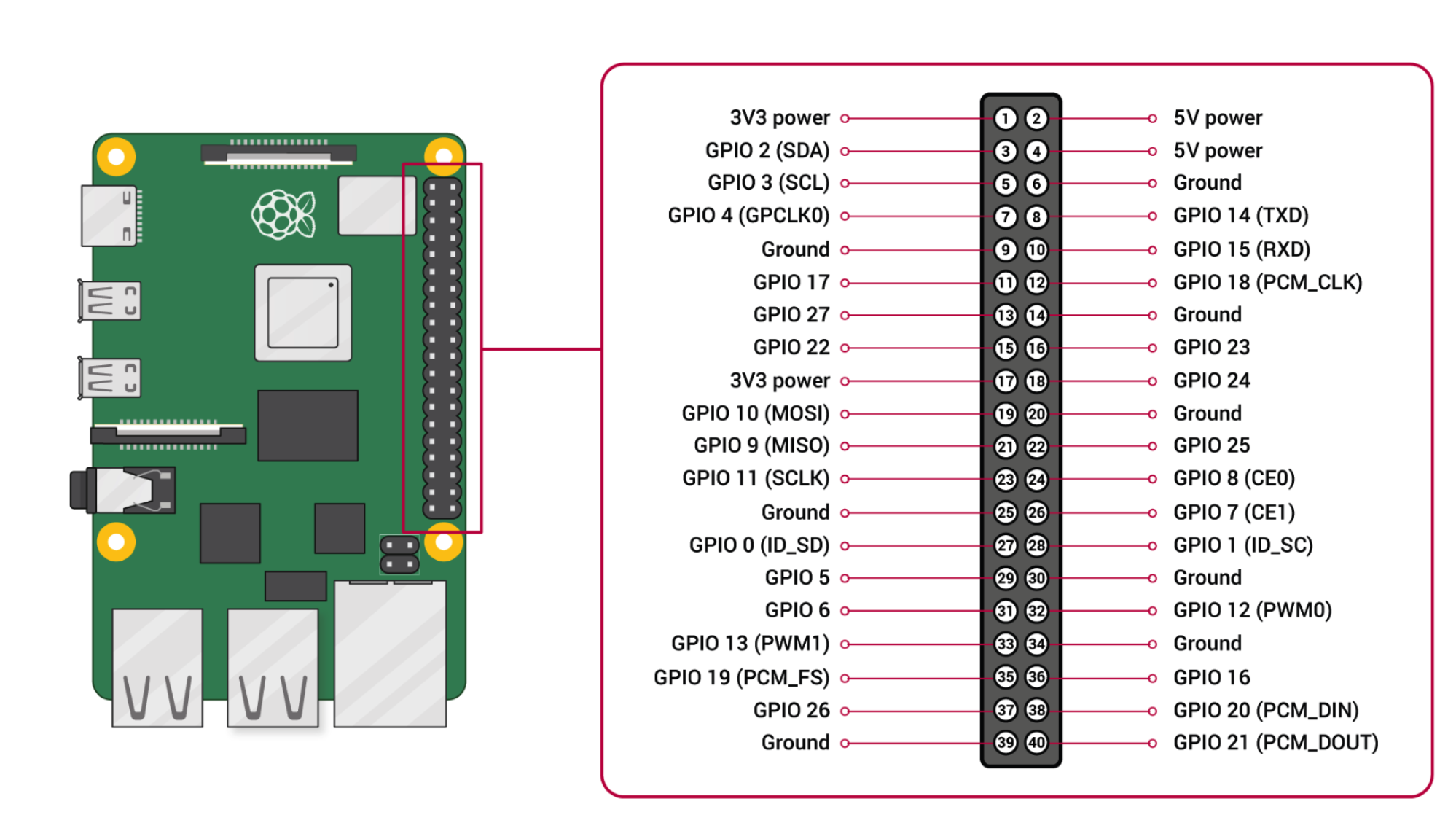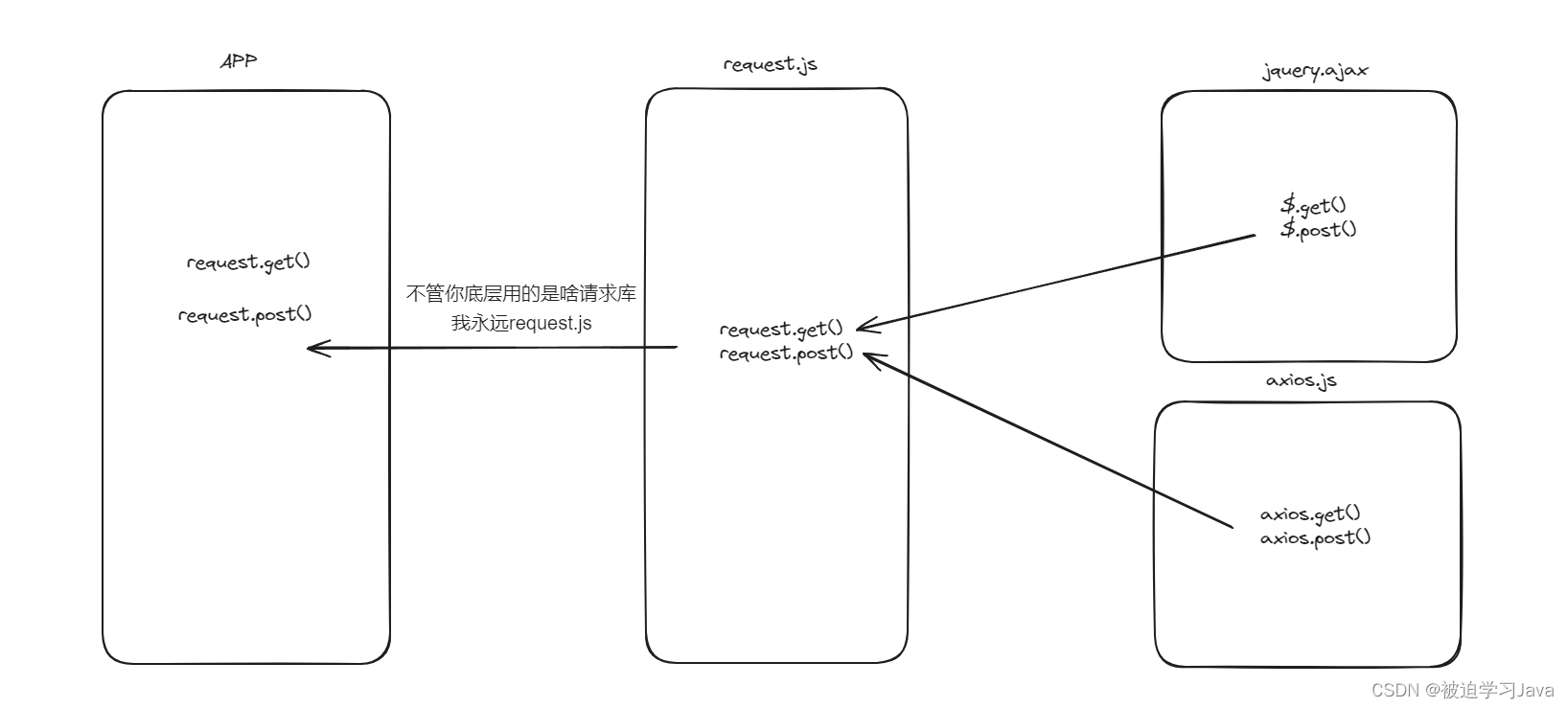文章目录
- 前言
- 2 核心功能
- 2.1 条件构造器
- 2.1.1 Wrapper
- 2.1.2 QueryWrapper
- 2.1.3 UpdateWrapper
- 2.1.4 LambdaQueryWrapper
- 2.2 自定义SQL
- 2.2.1 基本用法
- 2.2.2 多表关联
- 2.3 Service接口
- 2.3.1 IService
- 2.3.1.1 save
- 2.3.1.2 remove
- 2.3.1.3 update
- 2.3.1.4 get
- 2.3.1.5 list
- 2.3.1.6 count
- 2.3.1.7 page
- 2.3.2 基本用法
前言
MyBatisPlus详解系列文章:
MyBatisPlus详解(一)项目搭建、@TableName、@TableId、@TableField注解与常见配置
2 核心功能
2.1 条件构造器
2.1.1 Wrapper
在BaseMapper接口提供的相关方法中,除了以id作为where条件,还支持更加复杂的where条件,即条件构造器Wrapper:

Wrapper是条件构造器的抽象类,其下有很多默认实现,继承关系如图:

Wrapper的子类AbstractWrapper提供了where中包含的所有条件构造方法:

而QueryWrapper在AbstractWrapper的基础上拓展了一个select方法,允许指定查询字段:

而UpdateWrapper在AbstractWrapper的基础上拓展了一个set方法,允许指定SQL中的SET部分:

2.1.2 QueryWrapper
使用QueryWrapper构建查询条件,例如:
select id, username, info, balance from t_user where id = 3 and username like '%o%' and balance >= 1000
java">@Test
public void testQueryWrapper() {// select id, username, info, balance from t_user// where id = 3 and username like '%o%' and balance >= 1000QueryWrapper<User> wrapper = new QueryWrapper<User>()// 设置需要查询的字段.select("id", "username", "info", "balance")// id = 3.eq("id", 3)// like '%o%'.like("username", "o")// balance >= 1000.ge("balance", 1000);List<User> userList = userMapper.selectList(wrapper);userList.forEach(System.out::println);
}
执行以上单元测试结果如下:
==> Preparing: SELECT id,username,info,balance FROM t_user WHERE (id = ? AND username LIKE ? AND balance >= ?)
==> Parameters: 3(Integer), %o%(String), 1000(Integer)
<== Total: 1
User(id=3, username=Hope, password=null, phone=null, info={"age": 25, "intro": "上进青年", "gender": "male"}, status=null, balance=20000, createTime=null, updateTime=null)
update t_user set balance = 2000 where username = 'Jack'
java">@Test
void testUpdateByQueryWrapper() {// update t_user set balance = 2000 where username = 'Jack'QueryWrapper<User> wrapper = new QueryWrapper<User>()// username = 'Jack'.eq("username", "Jack");// 2.更新数据User user = new User();user.setBalance(2000);userMapper.update(user, wrapper);
}
执行以上单元测试结果如下:
==> Preparing: UPDATE t_user SET balance=? WHERE (username = ?)
==> Parameters: 2000(Integer), Jack(String)
<== Updates: 0
2.1.3 UpdateWrapper
如上面的单元测试testUpdateByQueryWrapper()所示,update()方法更新时只能直接赋值,对于一些复杂的需求就难以实现,例如:
sql">UPDATE t_user SET balance = balance - 200 WHERE id in (1, 2, 4);
SET语句的赋值结果是基于字段现有值的,这个时候就要利用UpdateWrapper中的setSql()方法了:
java">@Test
void testUpdateWrapper() {List<Long> ids = Arrays.asList(1L, 2L, 4L);// 1.生成SQLUpdateWrapper<User> wrapper = new UpdateWrapper<User>()// SET balance = balance - 200.setSql("balance = balance - 200")// WHERE id in (1, 2, 4).in("id", ids);// 2.更新// 注意第一个参数为null,则会基于UpdateWrapper中的setSQL来更新userMapper.update(null, wrapper);
}
执行以上单元测试结果如下:
==> Preparing: UPDATE t_user SET balance = balance - 200 WHERE (id IN (?,?,?))
==> Parameters: 1(Long), 2(Long), 4(Long)
<== Updates: 2
2.1.4 LambdaQueryWrapper
无论是QueryWrapper还是UpdateWrapper,在构造条件的时候都需要写死字段名称,会出现字符串魔法值。这在编程规范中显然是不推荐的。
而要不写字段名,又能知道字段名,其中一种办法是基于变量的gettter方法结合反射技术。为此,MybatisPlus又提供了一套基于Lambda的Wrapper,包含两个:LambdaQueryWrapper和LambdaUpdateWrapper。
java">@Test
public void testLambdaQueryWrapper() {// select id, username, info, balance from t_user// where id = 3 and username like '%o%' and balance >= 1000LambdaQueryWrapper<User> wrapper = new LambdaQueryWrapper<User>()// 设置需要查询的字段.select(User::getId, User::getUsername, User::getInfo, User::getBalance)// id = 3.eq(User::getId, 3)// username like '%o%'.like(User::getUsername, "o")// balance >= 1000.ge(User::getBalance, 1000);List<User> userList = userMapper.selectList(wrapper);userList.forEach(System.out::println);
}
执行该单元测试,可以得到和上面的testQueryWrapper()一样的结果,但这种写法不需要将字段名写死。未来如果需要修改字段名,也不需要这里的逻辑代码。
2.2 自定义SQL
在单元测试testUpdateWrapper(),编写了这样一行代码:.setSql("balance = balance - 200"),这种写法其实也是不好的,因为SQL语句最好都维护在持久层,而不是业务层。
为此,MyBatis提供了自定义SQL功能,即利用Wrapper构建复杂的where条件,然后自己定义SQL语句剩余的部分。
也就是说,UPDATE t_user SET balance = balance - 200自己定义,WHERE id in (1, 2, 4)利用Wrapper构建。
2.2.1 基本用法
例如单元测试testUpdateWrapper()可以这样修改:
java">@Test
public void testUpdateWrapper2() {List<Long> ids = Arrays.asList(1L, 2L, 4L);// 1.生成SQLUpdateWrapper<User> wrapper = new UpdateWrapper<User>()// SET balance = balance - 200// .setSql("balance = balance - 200")// WHERE id in (1, 2, 4).in("id", ids);// 2.更新// userMapper.update(null, wrapper);// 改为调用自定义的Mapper方法,直接传递WrapperuserMapper.deductBalanceByIds(200, wrapper);
}
然后在UserMapper中定义deductBalanceByIds()方法:
java">// com.star.learning.mapper.UserMapper@Update("UPDATE t_user SET balance = balance - #{money} ${uw.customSqlSegment}")
void deductBalanceByIds(@Param("money") int money, @Param("uw") UpdateWrapper<User> wrapper);
执行修改后的单元测试,执行结果和原来的是一样的。
2.2.2 多表关联
理论上来讲MyBatisPlus是不支持多表查询的,不过仍然可以利用Wrapper构建复杂where条件结合自定义SQL来实现多表查询的效果。
例如,要查询出所有收货地址在北京并且用户id在1、2、4之中的用户,其SQL语句为:
sql">SELECT * FROM t_user u
INNER JOIN t_address a ON a.user_id = u.id
WHERE u.id IN (1,2,4)
AND a.city = '北京'
编写单元测试,利用Wrapper构建复杂where条件,并调用自定义的Mapper方法:
java">@Test
public void testMultiTableQuery() {List<Long> ids = Arrays.asList(1L, 2L, 4L);// 1.利用Wrapper构建复杂where条件QueryWrapper<User> wrapper = new QueryWrapper<User>().in("u.id", ids).eq("a.city", "北京");// 2.调用自定义的Mapper方法User user = userMapper.queryUserByIdAndCity(wrapper);System.out.println(user);
}
java">// com.star.learning.mapper.UserMapper@Select("SELECT * FROM t_user u INNER JOIN t_address a ON a.user_id = u.id ${ew.customSqlSegment}")
User queryUserByIdAndCity(@Param("ew") QueryWrapper<User> wrapper);
执行以上单元测试,结果如下:
==> Preparing: SELECT * FROM t_user u INNER JOIN t_address a ON a.user_id = u.id WHERE (u.id IN (?,?,?) AND a.city = ?)
==> Parameters: 1(Long), 2(Long), 4(Long), 北京(String)
<== Total: 1
User(id=2, username=Rose, password=123, phone=13900112223, info={"age": 19, "intro": "青涩少女", "gender": "female"}, status=1, balance=200, createTime=2024-04-21T10:13:35, updateTime=2024-04-21T16:10:20)
2.3 Service接口
MybatisPlus不仅提供了BaseMapper接口,还提供了通用的Service接口及默认实现ServiceImpl,封装了一些常用的service模板方法。
2.3.1 IService
2.3.1.1 save

save:插入一条记录saveBatch:批量插入多条记录saveOrUpdate:记录存在则更新记录,否则插入一条新记录saveOrUpdateBatch:记录存在则批量修改,否则批量插入
2.3.1.2 remove

remove:根据条件删除removeById:根据ID删除removeByIds:根据ID批量删除removeByMap:根据Map中的键值对为条件删除removeBatchByIds:批量删除(jdbc批量提交)
2.3.1.3 update

update(Wrapper<T>):根据UpdateWrapper修改,Wrapper中包含set和where部分update(T,Wrapper<T>):按照T内的数据修改与Wrapper匹配到的数据updateById:根据id修改updateBatchById:根据id批量修改
2.3.1.4 get

getById:根据id查询getOne(Wrapper<T>):根据Wrapper查询1条记录getBaseMapper:获取对应实体的BaseMappergetMap(Wrapper<T>):根据Wrapper查询1条记录,封装为Map
2.3.1.5 list

list():查询所有list(Wrapper<T>):根据Wrapper条件查询列表listByIds():根据ID集合查询列表
2.3.1.6 count

count():查询总记录数count(Wrapper<T>):根据Wrapper条件查询总记录数
2.3.1.7 page

page(IPage):无条件翻页查询page(IPage, Wrapper<T>):根据Wrapper条件翻页查询
2.3.2 基本用法
创建一个IUserService接口,继承IService接口以拓展方法;同时,自定义UserServiceImpl实现类,继承ServiceImpl实现类,并实现IUserService接口。
java">// com.star.learning.service.IUserServicepublic interface IUserService extends IService<User> {
}
java">// com.star.learning.service.impl.UserServiceImpl@Service
public class UserServiceImpl extends ServiceImpl<UserMapper, User> implements IUserService {
}
这样配置之后,导入IUserService接口,即可以使用IService接口中定义的各种方法。
接下来,实现下面这个接口:
| 接口 | 请求方式 | 请求路径 | 请求参数 | 返回值 |
|---|---|---|---|---|
| 新增用户 | POST | /user/add | User | 无 |
首先,导入相关依赖:
<dependency><groupId>org.springframework.boot</groupId><artifactId>spring-boot-starter-web</artifactId>
</dependency>
然后创建一个UserController类,并编写一个addUser()方法:
java">// com.star.learning.controller.UserController@RestController
@RequestMapping("/user")
public class UserController {@Autowiredprivate IUserService userService;@PostMapping("/add")public void addUser(@RequestBody User user) {boolean save = userService.save(user);System.out.println("新增用户结果 => " + save);}
}
最后进行功能测试,调用/user/add接口,查看控制台打印信息:
==> Preparing: INSERT INTO t_user ( username, password, phone, info, balance ) VALUES ( ?, ?, ?, ?, ? )
==> Parameters: Jim(String), 123456(String), 999(String), {"age": 20, "intro": "佛系青年", "gender": "male"}(String), 500(Integer)
<== Updates: 1
新增用户结果 => true
接下来再来实现3个接口:
| 接口 | 请求方式 | 请求路径 | 请求参数 | 返回值 |
|---|---|---|---|---|
| 根据id查询用户 | GET | /user/{id} | id | User |
| 根据id集合批量查询用户 | GET | /user/{id} | id | List<User> |
| 删除用户 | DELETE | /user/{id} | id | 无 |
其代码如下:
java">// com.star.learning.controller.UserController@GetMapping("/{id}")
public User getById(@PathVariable("id") Long userId) {User user = userService.getById(userId);System.out.println("根据id查询用户 => " + user);return user;
}@GetMapping
public List<User> queryUserByIds(@RequestParam("ids") List<Long> ids){List<User> users = userService.listByIds(ids);System.out.println("根据id集合查询用户列表 => " + users);return users;
}@DeleteMapping("/{id}")
public void removeUserById(@PathVariable("id") Long userId){boolean remove = userService.removeById(userId);System.out.println("根据id删除用户 => " + remove);
}
调用这3个接口,查看控制台打印信息:
// 根据id查询用户
==> Preparing: SELECT id,username,password,phone,info,status,balance,create_time,update_time FROM t_user WHERE id=?
==> Parameters: 2(Long)
<== Total: 1
根据id查询用户 => User(id=2, username=Rose, password=123, phone=13900112223, info={"age": 19, "intro": "青涩少女", "gender": "female"}, status=1, balance=200, createTime=2024-04-21T10:13:35, updateTime=2024-04-21T16:10:20)// 根据id集合批量查询用户
==> Preparing: SELECT id,username,password,phone,info,status,balance,create_time,update_time FROM t_user WHERE id IN ( ? , ? , ? )
==> Parameters: 1(Long), 2(Long), 3(Long)
<== Total: 2
根据id集合查询用户列表 => [User(id=2, username=Rose, password=123, phone=13900112223, info={"age": 19, "intro": "青涩少女", "gender": "female"}, status=1, balance=200, createTime=2024-04-21T10:13:35, updateTime=2024-04-21T16:10:20), User(id=3, username=Hope, password=123, phone=13900112222, info={"age": 25, "intro": "上进青年", "gender": "male"}, status=1, balance=20000, createTime=2024-04-21T10:13:35, updateTime=2024-04-21T11:12:48)]// 根据id删除用户
==> Preparing: DELETE FROM t_user WHERE id=?
==> Parameters: 2(Long)
<== Updates: 1
根据id删除用户 => true
可以看到,上述4个接口都直接在Controller类中即可实现,无需编写任何Service代码,非常方便。
不过,一些带有业务逻辑的接口则需要在Service中自定义实现了。例如下面这个接口:
| 接口 | 请求方式 | 请求路径 | 请求参数 | 返回值 |
|---|---|---|---|---|
| 根据id扣减用户余额 | PUT | {id}/deduction/{money} | id,money | 无 |
java">// com.star.learning.controller.UserController@PutMapping("{id}/deduction/{money}")
public void deductBalance(@PathVariable("id") Long id, @PathVariable("money")Integer money){System.out.println("扣减id=" + id + "的用户的余额" + money);userService.deductBalance(id, money);
}
java">// com.star.learning.service.IUserServicepublic interface IUserService extends IService<User> {void deductBalance(Long userId, Integer money);
}
java">// com.star.learning.service.impl.UserServiceImpl@Service
public class UserServiceImpl extends ServiceImpl<UserMapper, User> implements IUserService {@Autowiredprivate UserMapper userMapper;@Overridepublic void deductBalance(Long userId, Integer money) {// 1.查询用户User user = getById(userId);System.out.println(user);// 2.判断用户状态if (user == null || user.getStatus() == 2) {throw new RuntimeException("用户状态异常");}// 3.判断用户余额if (user.getBalance() < money) {throw new RuntimeException("用户余额不足");}// 4.扣减余额// 2.2节自定义SQL创建了deductBalanceByIds方法可以直接使用UpdateWrapper<User> wrapper = new UpdateWrapper<User>().eq("id", userId);userMapper.deductBalanceByIds(money, wrapper);}
}
调用/user/3/deduction/200接口,查看控制台打印信息:
扣减id=3的用户的余额200
==> Preparing: SELECT id,username,password,phone,info,status,balance,create_time,update_time FROM t_user WHERE id=?
==> Parameters: 3(Long)
<== Total: 1
User(id=3, username=Hope, password=123, phone=13900112222, info={"age": 25, "intro": "上进青年", "gender": "male"}, status=1, balance=20000, createTime=2024-04-21T10:13:35, updateTime=2024-04-21T11:12:48)
==> Preparing: UPDATE t_user SET balance = balance - ? WHERE (id = ?)
==> Parameters: 200(Integer), 3(Long)
<== Updates: 1
…
本节完,更多内容请查阅分类专栏:MyBatisPlus详解
感兴趣的读者还可以查阅我的另外几个专栏:
- SpringBoot源码解读与原理分析(已完结)
- MyBatis3源码深度解析(已完结)
- Redis从入门到精通(已完结)
- 再探Java为面试赋能(持续更新中…)






